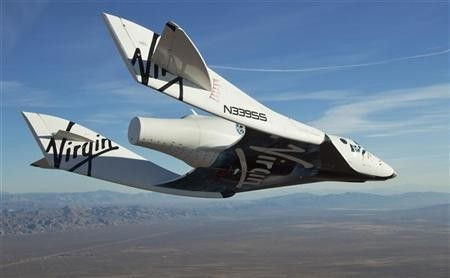Virgin Galactic Aims to Test Fly Ship in Space This Year

(Reuters) - Virgin Galactic, an offshoot of Richard Branson's Virgin Group, expects to test fly its first spacecraft beyond the Earth's atmosphere this year, with commercial suborbital passenger service to follow in 2013 or 2014, company officials said on Monday.
Nearly 500 customers have signed up for rides on SpaceShipTwo, a six-passenger, two-pilot spaceship being built and tested by Scaled Composites, an aerospace company founded by aircraft designer Burt Rutan and now owned by Northrop Grumman.
The suborbital flights, which cost $200,000 per person, are designed to reach an altitude of about 68 miles, giving fliers a few minutes to experience zero gravity and glimpse Earth set against the blackness of space.
"In the suborbital area, there are a lot of things to be done. This is an area that has been essentially absent for about four decades," said Neil Armstrong, who was a test pilot for the 1960s-era X-15 research plane before becoming a U.S. astronaut and commander of the first mission to land on the moon.
"There's a lot of opportunity," Armstrong told about 400 people attending the Next-Generation Suborbital Researchers Conference in Palo Alto, California. "I certainly hope that some of the new approaches will prove to be profitable and useful."
Virgin Galactic is the most visible of a handful of companies developing spaceships for tourism, research, educational and business purposes.
SpaceShipTwo, the first of Virgin's planned five-ship fleet, has completed 31 atmospheric test flights - 15 attached to its carrier aircraft WhiteKnightTwo, and 16 glide tests, William Pomerantz, Virgin Galactic's vice president of special projects, said in a speech to the conference.
Preparations for the ship's first rocket-powered flights are under way at Scaled Composites' Mojave, California, plant and expected to take place this year.
"We hope to have the rocket motor in the spaceship later this year and start powered flight testing," Virgin Galactic chief test pilot David Mackay told the conference.
"We would like to be the first to do this, but we're not in a race with anyone. This is not a Cold War-era space race."
"We flow pretty quickly from first powered flight to first flight to space and then it's not terribly long from there until we have our first commercial flight to space," Pomerantz told reporters later.
He said passenger service could begin in 2013 or 2014, depending on the results of the test flights and other factors, such as pilot training.
No one knows what the suborbital spaceflight market might be worth, but Andrew Nelson, chief operating officer of XCOR Aerospace, another aspiring commercial spaceline, put the figure at $1 trillion.
XCOR, which announced on Monday it had closed a $5 million round of equity funding, now has enough money to manufacture its
Lynx suborbtial vehicle. The company charges $90,000 for rides.
When asked about the potential impact of a commercial suborbital industry, Armstrong noted that the X-15 program, designed to investigate the problems of high-speed, high-altitude flight and devise possible solutions, helped United States become the world's largest aeronautical product exporter.
"We're in an entirely new environment now," Armstrong said, "with different objectives, different participants, different goals. We can't imagine all the opportunities that exist."
© Copyright Thomson Reuters 2024. All rights reserved.




















